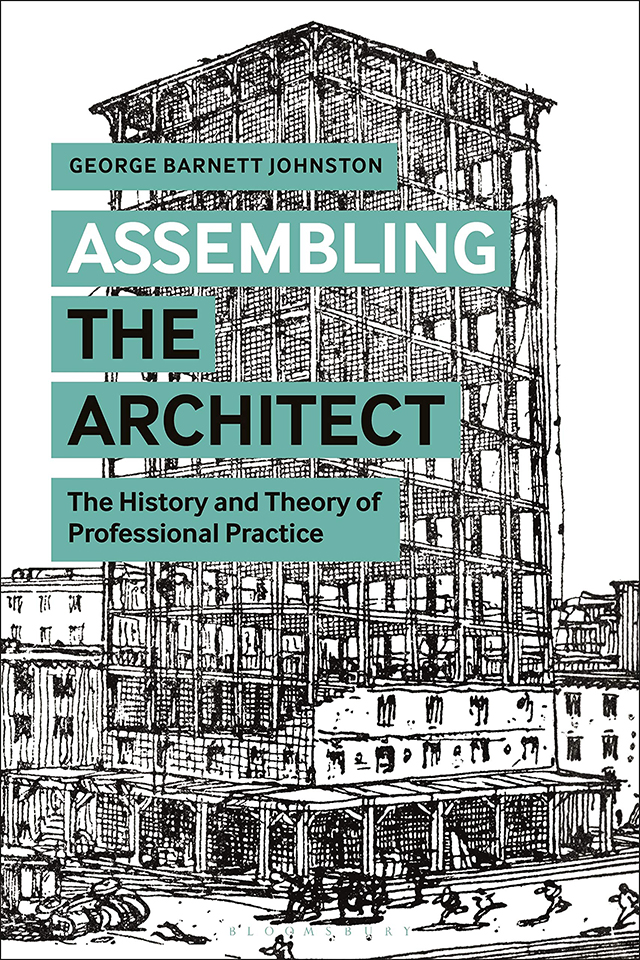Assembling the Architect
Assembling the Architect: The History and Theory of Professional PracticeGeorge Barnett JohnstonBloomsbury Visual Arts, January 2020Paperback | 6-1/4 x 9 inches | 296 pages | 74 illustrations | English | ISBN: 978-1350126862 | $34.95PUBLISHER'S DESCRIPTION: Assembling the Architect explores the origins and history of architectural practice. It unravels the competing interests that historically have structured the field and cultivates a deeper understanding of the contemporary profession. Focusing on the period 1870 to 1920 when the foundations were being laid for the U.S. architectural profession that we recognize today, this study traces the formation and standardization of the fundamental relationships among architects, owners, and builders, as codified in the American Institute of Architects’ very first Handbook of Architectural Practice. It reveals how these archetypal roles have always been fluid, each successfully redefining their own agency with respect to the others in the constantly-shifting political economy of building. Far from being a purely historical study, the book also sheds light on today’s digitally-enabled profession. Contemporary architectural tools and disciplinary ideals continue to be shaped by the same fundamental tensions, and emergent modes of practice such as BIM (Building Information Modelling) and IPD (Integrated Project Delivery) represent the realization of programs and agendas that have been over a century in play. George Barnett Johnston is professor of architecture at Georgia Tech and principal of Johnston+Dumais [architects]. He has over 40 years of experience as an architect, educator, academic leader, and cultural historian. REFERRAL LINKS: dDAB COMMENTARY: 101 Park Avenue is a 50-story wedge of glass on the northeast corner of 40th Street and Park Avenue, just south of Grand Central Terminal. Designed by Eli Attia for developers Harold and Peter Kalikow, the office tower was praised by Ada Louise Huxtable in 1979 when it was unveiled: "an exercise in the kind of creative quality that until very recently has been conspicuously absent from the New York scene." In that same article the critic dismissed the new tower's predecessor: "By a quirk of architectural fate, 101 Park, long the home of architects' offices and building product displays, is a particularly undistinguished structure." Known as The Architects' Building (but also as the "Shoestring Building" for its architectural thrift), the previous 101 Park was designed by Ewing & Chappell with LaFarge & Morris and completed in 1913, when it was fully leased by dozens of architecture, engineering, and construction firms. The ground floor was given over to the Architects' Sample Company, where architects and clients could select materials for their projects, and upstairs were the offices, laid out for "greater efficiency in handling the working forces of those who are fortunate enough to be numbered as tenants." These words were part of an account written by D. Everett Waid for a 1913 issue of The Brickbuilder, who also noted: "It seems quite ideal to be able to go next door for a criticism, or to borrow a draftsman, or to admire a set of competition drawings." Although it was nothing special on the outside (a sentiment I'd also levy at its glassy replacement), the original 101 Park Avenue was clearly something important inside, at least to architects. This hub of architecture and building should be more well known, but even the first AIA Guide to New York City, from 1968, only gave it two lines and no mention of its architects. It was George Barnett Johnston's Assembling the Architect that just alerted me to the existence of The Architects' Building. It makes an appearance in the second chapter, which also spends a good deal of time on George S. Chappell of Ewing & Chappell, the firm that designed the building but also had their offices inside it. Readers get a peek inside the offices of the partners and the "draughting room" but also learn about Chappell's writing, of which his legacy was made. He wrote for Vanity Fair, launched "The Sky Line" column at The New Yorker (his successor was Lewis Mumford), and wrote some travel parodies under the pseudonym Walter E. Traprock. Johnston should be thanked for introducing Chappell to me and no doubt many more architects not familiar with his multifaceted life. But he is just one now little known character in the book, connected directly to one of the others: Rockwell Kent, who illustrated some of Chappell's pieces and in turn illustrated Architec-tonics: The Tales of Tom Thumtack, Architect written by another, architect Frederick Squires, in 1914. (Images from it are below.) In Johnston's hands, Squires's book is presented as a "handbook," though its practical use by architects was considerably less than Frank Miles Day's The Handbook of Architectural Practice, which was first published in 1920 (two years after Day died) and whose 15th edition was published a

Assembling the Architect: The History and Theory of Professional Practice
George Barnett Johnston
Bloomsbury Visual Arts, January 2020
Paperback | 6-1/4 x 9 inches | 296 pages | 74 illustrations | English | ISBN: 978-1350126862 | $34.95
PUBLISHER'S DESCRIPTION:
REFERRAL LINKS:
IMAGES:










